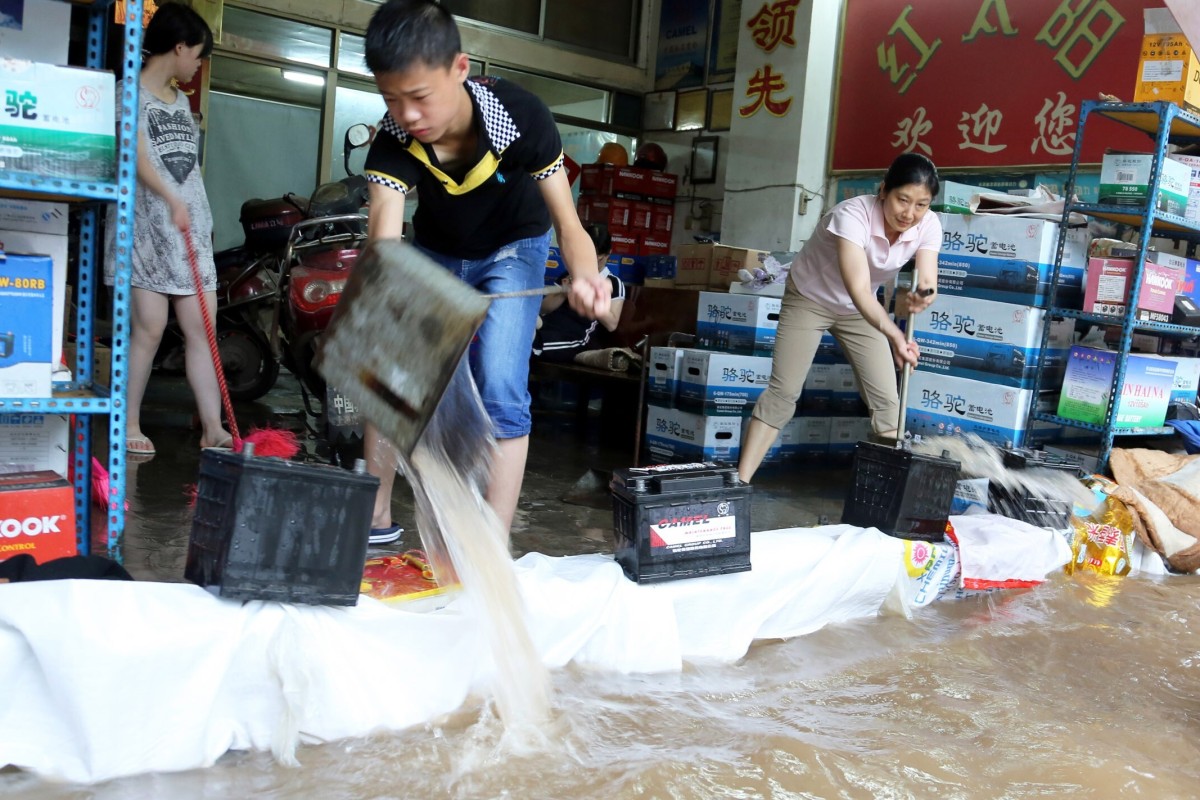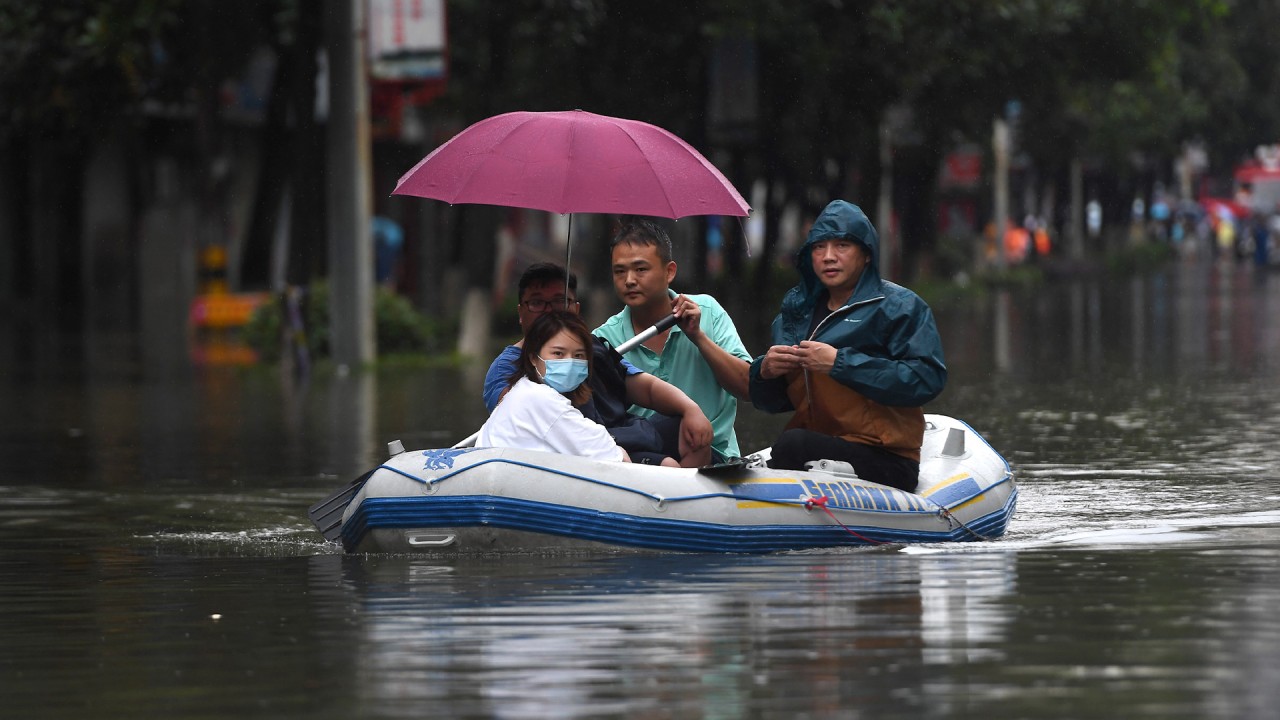begin quote from:
China’s economic recovery under threat from fresh coronavirus outbreaks and floods, analysts say
- China avoided a recession after its economy grew by 3.2 per cent in the second quarter of 2020, although retail sales remain fragile
- Floods have so far affected 27 of China’s provincial-level jurisdictions, while fresh outbreaks have been detected in the likes of Xinjiang and Liaoning
The Chinese government estimates that the economic costs of the floods, which have so far affected 27 of China’s provincial-level jurisdictions, is likely to hit 144.43 billion yuan (US$20.6 billion). Photo: AP
Fresh clusters of coronavirus cases along with severe flooding may hold back China’s recovery from the pandemic as consumption and construction are likely to be hit, according to analysts.
China avoided a recession after its economy grew by
of 2020, the first major economy to show a recovery from the damage caused by the coronavirus after its gross domestic production (GDP) shrank by 6.8 per cent in the first three months of the year.
But consumption, which was badly hit by the coronavirus, remains a fragile spot for China after retail sales – a key measurement of consumption fell by 1.8 per cent in June, although this was better than the 2.8 per cent decline in May.
“Consumption remains weak. Retail sales are stabilising, but even in June, remained below the levels recorded at the same time in 2019,” said S&P Global Ratings Asia-Pacific chief economist Shaun Roache. “Export growth stays patchy given the stuttering recovery in the rest of the world.”
Some enterprises … reported that flood-related disasters caused disruptions to logistics and transportation, along with problems like flooding in plants, equipment and inventory
And China’s road to recovery might be held back by some of the heaviest rainfall on record, bringing in its most punishing flood season, which is set to disrupt manufacturing and construction, a key driver for China’s growth in the last quarter.
“Small companies continue to face pressure on both supply and demand,” said Zhao Qinghe, senior statistician at the National Bureau of Statistics (NBS) when announcing China’s official
on Friday.
“Some enterprises … reported that flood-related disasters caused disruptions to logistics and transportation, along with problems like flooding in plants, equipment and inventory.”
China’s official manufacturing PMI was 51.1 for July, with a reading above 50.0 signifying growth in factory output, while the non-manufacturing PMI was 54.2, with both surveys reporting positive outlooks for five consecutive months.
Weak demand and reimposed lockdown measures in some regions in China as a result of a resurgence of coronavirus cases are also set to add more pressure to consumption, analysts said.
“The floods have wreaked havoc in many places. But I think that, at the macroeconomic level, the damage is not large enough to really affect growth of the national economy. Also, there could be some impact on food prices, but that is likely to be transitory and modest,” said Louis Kuijs, head of Asia economics at Oxford Economics.
“I think the new Covid-19 cases could potentially have a larger impact, macroeconomically, since an outbreak in one place could affect people’s behaviour nationwide, in terms of making people more reluctant to go out and engage normally.”
The Chinese government estimates that the economic costs of the floods, which have so far affected 27 of China’s provincial-level jurisdictions, is likely to hit 144.43 billion yuan (US$20.6 billion).
“This year’s flood disaster has seriously affected production and living conditions in some regions,” said NBS spokeswoman Liu Aihua when commenting on China’s second quarter economic recovery earlier this month, while adding that food prices have already gone up as a result.
Huatai Securities said in a report last week that fixed asset investment in July may drop slightly to around 4 per cent to 4.5 per cent from 5.3 per cent, driven by the falling investment in infrastructure and real estate as a result of the heavy rainfall.
This week, China reported the highest number of new coronavirus infections in over three and half months, with the majority coming from the western region of Xinjiang.
At least nine Chinese cities have also reported cases linked to Dalian, the port city in the northeastern province of Liaoning, where a new cluster emerged within the last week.
If there are more provinces that experience a second round of outbreaks in the future, the recovery of domestic consumption will be delayed
China International Capital Corporation (CICC) analysts said in a report on Wednesday that the new round of infections in China and in other countries could take a toll on consumption.
After Beijing endured a resurgence of coronavirus cases in June, retail sales in China’s capital city dropped 26.8 per cent from the same month last year, compared with May’s decline of 18 per cent compared to a year earlier.
“Since July, the second round of the
has been basically brought under control, but a new round has broken out in Xinjiang and Liaoning,” the CICC report said.
“Japan, Singapore, Hong Kong and other places that have good epidemic prevention and control are seeing a fresh round of new infections, reflecting the increasing difficulty of global outbreak prevention and control. If there are more provinces that experience a second round of outbreaks in the future, the recovery of domestic consumption will be delayed.”
04:39
Double trouble for China’s porcelain capital as Yangtze River floods add to pandemic woes
The fresh cluster of coronavirus cases may also weigh on the services sector in China because of reimposed lockdown measures in some regions, Japanese investment bank Nomura said in a report on Tuesday.
Nomura analysts also expect the manufacturing industry to “face stronger headwinds from falling external demand and the ongoing floods”.
“We believe Beijing will likely maintain its easing stance through the remainder of this year as the economy is still far from a full recovery and faces heightened uncertainty,” said Nomura.
China's healthcare sector was one of the best-performing equity classes globally in the first half of 2020. Get a comprehensive industry review and insights on Covid-19 induced market shifts with the China Healthcare Report, brought to you by SCMP Research.
for our 50% early bird discount now. You will also receive access to 6 closed-door webinars led by China healthcare’s most influential C-suite executives. Offer Valid until August 10th 2020.














No comments:
Post a Comment